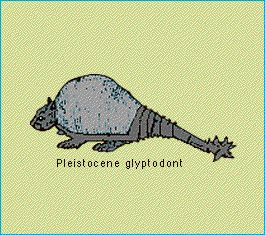Great American Interchange

The term biotic interchange is used to describe the events that take place when two previously separate faunas come into contact. Several biotic interchanges are known from the history of life.
The Great American Interchange
The most famous is the Great American Interchange, which occurred when the modern Isthmus of Panama rose out of the sea and the South and North American continents reconnected.
The Great American Interchange is one of the most dramatic case studies in historical biogeography. The mammalian faunas of North and South America have only been connected, by a narrow isthmus, for less than 3 million years. Yet 50% of the mammalian genera in the South are now of northern origin, and such wonderful animals as
• rhinoceros-sized rodents,
• giant ground sloths, and
• glyptodonts, (pictured opposite)
were somehow involved in the general destruction of species during the interchange.
That the events of the Interchange were at least partly due to competition is very plausible: but to demonstrate it is a taller task.
Why did the North American mammals prove superior?
| Next |



